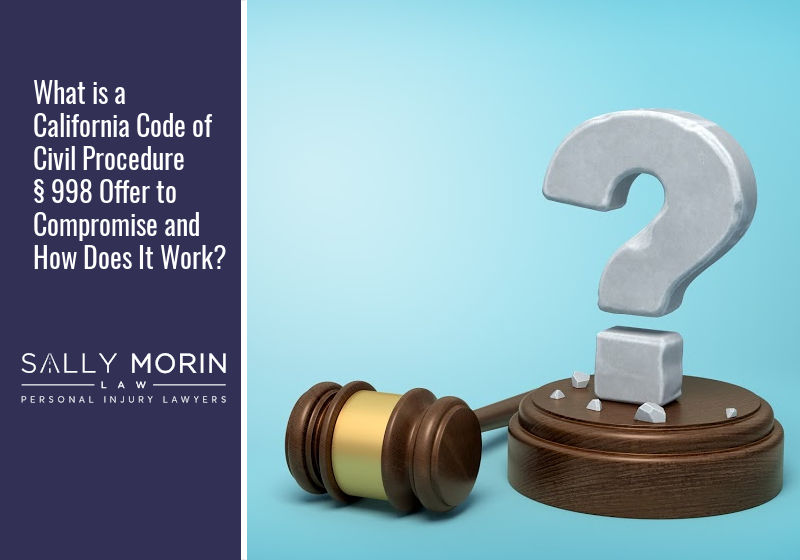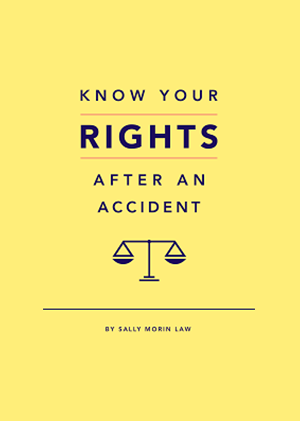A 998 Offer Can Speed Up Your Case and Support a Better Outcome
In a lawsuit, each person often pays their own legal fees. However, California law allows for a shift of legal costs from one party to the other through the use of California Code of Civil Procedure Section 998.
Lawyers commonly call this a 998 offer or just a 998, and it can be useful as a form of leverage in a personal injury case. Let’s look at why you would use the 998 and how it could help your case.
What is a 998 Offer and How Would I Use It?
A statutory offer to compromise, codified as the California Code of Civil Procedure (CCP) Section 998, allows for either the plaintiff or the defendant to offer the other party financial incentive to accept a pretrial settlement. It’s important to understand that timing is key with a 998 offer.
The offer can be made after litigation has begun but not during pre-litigation settlement negotiations. This means if a lawsuit has become inevitable and litigation is getting underway, a 998 offer can be made after the process starts but before you go to court.
Your 998 offer is effectively a cost-shifting option that places a greater financial burden on the party that does not accept a reasonable pre-trial settlement made in good faith. It allows you to suggest a deal with strings attached, where there is a disincentive to allow the case to proceed to arbitration or trial.
Why Would I Make a 998 Offer?
In many cases, making a 998 offer saves time, money, and hassle for everyone. It can help cut the legal process short and gives the other party a financial incentive to resolve things quickly with minimal back-and-forth.
Remember, the courts are always hoping that you’ll resolve your case without their help and they encourage parties to negotiate a pre-trial settlement whenever possible. By making a 998 offer, you’re showing a wholehearted attempt to arrange a pre-trial settlement.
Also, because a 998 offer shifts one party’s costs to the other party, it encourages all parties involved to think more carefully about the circumstances they’re facing. It causes the other side to reconsider the value of the case one last time before marching forward to trial.
What Happens After a 998 Offer?
Whether you make the 998 offer or the other side does, several different scenarios could play out afterward. Here are three common outcomes.
- If the case settles before trial, both parties involved in the settlement assume their own specific legal costs, regardless of the use of a 998 offer by either party.
- If the case goes through a trial, the party who wins at trial may transfer the financial responsibility for certain legal costs to the losing party using the 998 offer.
- If the case goes through a trial, the winning party may have to pay for their legal costs plus some of the legal costs of the other side. It depends on who made the 998 offer and whether or not they obtained a judgment better than the offer they received.
A 998 Offer is a Strategic Tool and Shifts Costs
Making a 998 offer can often force the settlement of a case and keep you from going to court. You’re making a bet that the other party will realize they’re unlikely to secure a more favorable judgment at trial.
Your lawyer and the other person’s lawyer will understand the value of the 998 offer and the odds involved. The person who loses in court may be on the hook for the other person’s legal costs and fees. Do they really want to take it that far?
The side receiving the offer has two options:
- Accept the offer, sign it, and settle the case
- Reject the offer and go to trial
Costs that may be shifted to the other party in a 998 offer include:
- Certain legal fees
- Document filing fees
- Jury fees
- Expert witness fees below a certain threshold
- Some costs associated with investigations
However, a 998 offer DOES NOT INCLUDE attorneys’ fees under California law. Also, liens are generally excluded when determining whether the judgment is more favorable than the offer to compromise. These are some things for both parties to consider as they weigh a 998 offer.
What are the Requirements for Making a 998 Offer?
The California Code of Civil Procedure lays out specific requirements for making a 998 offer. A 998 offer must be made in writing at least 10 days before trial or arbitration by either the plaintiff or defendant.
The written offer must state the terms and conditions of the offer, it must specifically refer to Section 998, and there must be a location where the other party signs to accept it. The offer must be made in good faith, not excessive, and reasonable – which we’ll discuss more below.
For the offer to be valid, it must be accepted within 30 days or before arbitration and trial, whichever occurs first. Otherwise, it is considered rejected. It can be revoked in writing within the 30-day period or at the start of arbitration or trial.
The Law Has a “Reasonable” Requirement for 998 Offers
California law requires that a 998 offer must be reasonable based on the information known by the party to whom the offer is made at the time the offer is made. Two components are used to determine if the offer is reasonable:
- The 998 offer must realistically foreshadow the outcome of the case as it would play out in a trial.
- It must also accurately reflect an estimated amount of damages a jury would award the plaintiff in a trial based on the defendant’s liability.
The court will evaluate whether the offer is reasonable by looking at whether both parties had enough facts and information about the merits of the claims in the lawsuit. This includes a consideration of issues like liability and damages sought by the plaintiff.
The 998 offer must be realistically based on the facts of the case and accurately estimate the damages a jury would award the plaintiff in a trial. Both parties to the 998 offer must have the necessary information to intelligently evaluate it and decide whether to take their chances at trial.
What Happens if the 998 Offer is Rejected?
Let’s look at a situation where the defendant makes a 998 offer but the plaintiff rejects it and opts to go to trial. Here’s what could happen from there.
The plaintiff may obtain a more favorable judgment than what they were offered in the 998, meaning they are not affected by it whatsoever. For example, if the plaintiff received a 998 offer for $100,000 but rejected it, the plaintiff must obtain a judgment in their favor for more than $100,000.
It’s also possible that the plaintiff obtains a less favorable judgment than the 998 offered. In this situation, the court or arbitrator may order that:
- The plaintiff pays the defendant’s post-offer costs
- The plaintiff loses the right to recover court costs
- The plaintiff is responsible for some or all of the expert witness fees for the trial
In this scenario, the plaintiff could obtain a $95,000 judgment which is decent, but less than the 998 offer made previously by the defendant. Although they received the $95,000 judgment in their favor, they still end up owing the defendant a lot of money in court and witness fees.
Beware! Personal injury cases in California can also come with additional interest fees. If a defendant rejects a plaintiff’s 998 offer and the plaintiff receives a more favorable judgment than the 998 offer, the plaintiff can collect prejudgment interest at a rate of 10%.
Depending on the size of the judgment and how long before trial the 998 offer was made, this interest could really add up. For example, if the 998 offer came 3 months before trial and was for $99,000, the interest could be around $2,500. For a $1,000,000 judgment, that would multiply to $25,000 in interest alone!
There are Special Rules for Cases Involving Multiple Parties
In cases with multiple plaintiffs or defendants, there are special rules to follow for 998 offers. As a general rule, a separate offer must be made to each party involved in a lawsuit. To be safe, the 998 offer should set out individual allocations of the proposed judgment to each party, with clarity about how much of the offer is allocated to each.
However, it’s not always so cut-and-dry. In cases like Meissner v. Paulson and others, joint offers by defendants without specific allocations to each plaintiff have been accepted by the court when there was proof the claim could not be divided.
This means a 998 offer can be made to single parties and not others. And in addition, the 998 offer must allow each party to accept the offer without the consent of all other parties.
Examples of 998 Offers in the Real World
Is all the legal explanation making your head spin? If so, let’s clarify things by looking at some simple examples of how 998 offers sometimes play out in personal injury cases.
Imagine that you’re suing someone and before your lawyer has even had time to review the basic facts of your case, the other side makes a 998 offer. This likely wouldn’t be considered a reasonable offer made in good faith under previous case law set by Najera v. Hurta.
In this case, the offer was too fast and the court will probably consider it premature and unreasonable. There was simply not enough time or litigation for a reasonable evaluation of the offer.
In another scenario, imagine that the other side made you a 998 offer that insultingly low after your loved one was killed in a wrongful death accident. Perhaps your case could potentially bring $10 million and their 998 offer was a nominal $2,500.
Based on previous California case law in Pineda v. Los Angeles Turf Club, Inc., this kind of offer may be viewed as a type of gamesmanship that doesn’t meet the reasonableness requirement. This means both sides should avoid the temptation to make a lowball offer or toss out an offer thinking there is no real risk involved.
Here’s the Bottom Line About 998 Offers
When used properly, a 998 offer can be a very effective tool to show you’re dealing in good faith, ready to negotiate, and willing to avoid going to trial. Whether you make or accept a 998 offer, it could bring a positive outcome that leaves you satisfied with the result.
However, it’s generally unwise to handle a 998 offer without the assistance of an experienced personal injury attorney. This is a complex topic that can become a legal minefield for the average person.
As you can see, this is why it’s essential to have a personal injury lawyer helping you negotiate the high stakes of a 998 offer. With Sally Morin Personal Injury Lawyers by your side, you’ll know when and how to use a 998 offer to your best advantage.
We Handle Your Personal Injury Claim So You Can Focus on Your Life
After an injury, contact the attorneys at Sally Morin Personal Injury Lawyers. We handle many areas of the law, including accidents involving undocumented people. We believe you should be able to focus on recovering while we handle the legal details.
We truly care about the people of California. Contact us today for a free online case evaluation.











